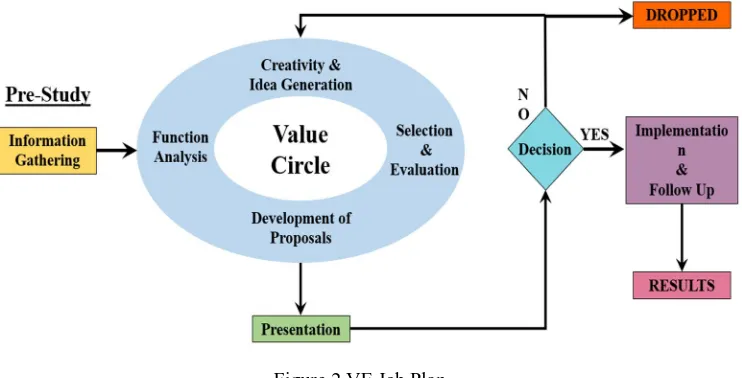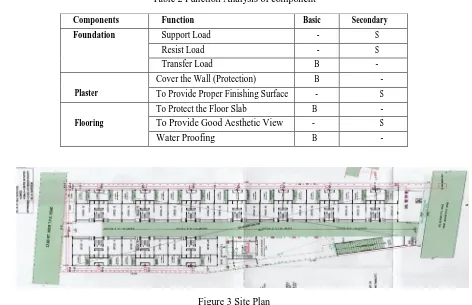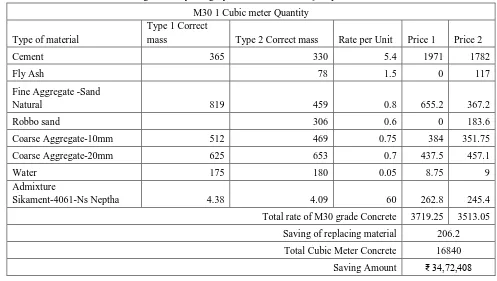Analysing the Cost Benefits of Value Engineering in
Construction Project by Replacing Material
Kirtan Katharotiya1 Jitendra Patel2
1
M Tech CPM Student, 2Assistant Professor, Department of Civil Engineering
Abstract:Value Engineering is powerful tools and methods to increasing value of projects also without affecting basic function. VE is systematic procedure to eliminating unnecessary cost mainly focusing in quality, Cost, Function. Its Job plan, Function Analysis analytically effect by replacing material also changes in method of construction is improved value. In that, some material replaced and so on cost is reduce without affecting environmental affect. VE standard format which required for construction industry but lack of information of this not applying properly. Through applying VE maximized profitability preparing cost model to check when higher cost perceived in that. When VE taking in real life case study to easily understanding how to work, how to do, how to applied in follow wise and using different phases. After all that VE is showcase outcomes for projects in sort VE is effective technique for presenting duration for vast construction filled.
Keywords: Value engineering, Cost Model, Different Phases, Alternatives Materials, Function Analysis, Job Plan, Unnecessary Cost
I. INTRODUCTION
Value engineering is one of the sequential process to improve value without affecting function. Saving money and at the same time, providing better value, is a concept that everyone can support.
Three basic elements provide a measure of value to the user: function, quality, and cost. These elements can be interpreted by the following relationship: Value=Function + Quality/ Cost
1)History Behind VE: VE starting from General Electric Co. during World War II because shortages of skilled labour, raw materials, and component parts. Lawrence Miles and Harry Erlicher at G.E. looked for acceptable substitutes. Then, Lawrence D. Miles, a staff engineer for General Electric, led this effort. Miles combined number of ideas and techniques to develop a successful methodological approach for ensuring value in a product. After that In 1957, the Navy’s Bureau of Ships became the first DoD organization to establish a formal VE program.
2)Reason for Unnecessary Cost: Shortage the information, Deficiency ideas, Instantaneous situations, Truthful incorrect politics, Variations idea of the user, organization or owner, Shortage of co-ordination, outdated standards and specifications.
[image:1.612.86.522.595.714.2]3)Benefits of Value Engineering: People are interested in saving money. Everyone is looking for a sound in- vestment with a high rate of return for their investment money. The benefits of spreading our investment dollar, building more for less money, increasing efficiency and cutting down our dependency on energy-intensive buildings (high energy cost) and plant facilities need to be recognized today and pursued in the future. Value engineering is a proven management technique using a systematized approach to seek out the best functional balance between the cost, reliability and performance of a product or project. The program seeks to improve the management capability of people and to promote progressive change identifying and removing unnecessary cost.
II. RESEARCH AIM, OBJECTIVES, JOB PLAN AND METHODOLOGY
A. Research Aim
Analyzing the cost benefits of value engineering concept in residential construction project: Case study on Residential Project in Ahmedabad.
B. Objectives
The following are the objectives of report, to achieve the aim as stated above:
1) To Study value engineering concepts and achieve consumer need which expected and provide quality work on their cost.
2) To study case studies on value engineering implementation in construction.
3) To implementation VE in any construction project and analyze cost effect on that.
C. Job Plan
[image:2.612.126.497.294.483.2]Value engineering job plan can be applying any subject and problems. It is vehicle to carried out the project from inception to conclusion. By adhering to certain formalities, the consideration is given to all necessary facets of problem. The job plan normally organized by a value team leader.
Figure 2 VE Job Plan
D. Research Methodology
Research methodology is depending upon models to facilitate VE application also different function of alternatives. There will be identified to concepts of project’s goals and objectives, and studying phases within using the inductive method.
The methodology is proposed by research is different also to clarify in methodology application and assuming benefits of Value engineering.
Main focuses are to minimize cost of project without affecting function also studying material specifications, Spaces used in design and maintenance and operation costs of commercial projects, or life cycle cost (LCC) of the project.
E. Methodology and Approach
Value methodology is systematic approach to following Job plan and is applied by a multidisciplinary team to improve the value of project through the analysis of functions.
III. IMPLIMENTATION OF VE ON COMMERCIALPROJECT
A. Information Phase
Purpose of this phase to targeted project collecting required information gathering all data which actually required like drawings, information of client, Design Criteria, Special Requirements, material used, Site condition, available utilities etc. This phase is targeted to all team which is involved in VE application to focus on common goal.
Table 1 Project Details Name of project Times Corporate park
Building Type Commercial type corporate house Name of Architecture Apurva Amin
Name of Structure Setu Infrastucture Number of Stories G + 4
Number of Units 20
1) Function Analysis: Functions of the different components of the Commercial building is described in which they are distributed in two parts
a) Basic function
[image:3.612.72.544.259.564.2]b) Secondary function For Example,
Table 2 Function Analysis of component
Figure 3 Site Plan
[image:3.612.144.469.641.733.2]2) Cost Model: After that working out of quantity to find out the classification of the cost consumed in the overall project and find out the most affected component in the building which have the higher value compare to other materials and components. So here in table no. 3 the cost of the all components of the building described.
Table 3 Work Cost and Percentage involve
Sr No Work Cost Percentage
1 Infrastructure development ₹ 9,62,12,524 20.71%
2 Structural Work ₹ 16,47,18,534 35.20%
3 Consultancy & Other Fee ₹ 6,84,14,346 14.62%
4 Mechanical ₹ 8,63,36,846 11.02%
5 Electrical ₹ 5,15,68,132 18.45%
Components Function Basic Secondary
Foundation Support Load - S
Resist Load - S
Transfer Load B -
Plaster
Cover the Wall (Protection) B -
To Provide Proper Finishing Surface - S
Flooring
To Protect the Floor Slab B -
To Provide Good Aesthetic View - S
Preparing Final Cost Model Chart
Chart 1 Cost Model Chart
B. Creative Phase
In this phase VE participants is asked to develop new ideas that go beyond the original concept of the designer by creative thinking. So that as per the details of the function analysis shown in the table no.1 and the cost distribution of the project in the different area, the Project manager/value engineering team should have to think about the different materials which can be replaced and fulfil the requirement of that materials. The A/E exercise creativity by formulating a combination of materials, system, processes and techniques to accomplish a required function. While, VE team, begins with the designer’s proposal and develops new ideas, combinations and techniques.
C. Judgement Phase
At this phase, screening of the ideas developed in creative phase are carried out. The process of selecting suitable ingredients of concrete and determining their relative amounts with the objective of producing a concrete of the required, strength, durability, and workability as economically as possible, is termed the concrete mix design. The proportioning of ingredient of concrete is governed by the required performance of concrete in 2 states, namely the plastic and the hardened states. If the plastic concrete is not workable, it cannot be properly placed and compacted. The property of workability, therefore, becomes of vital importance. The
Total Project Cost
₹ 46,79,50,382
Infrastucture development ₹ 9,62,12,524 Site Preparation ₹ 94,67,312 Earthwork ₹ 2,05,31,753 Water Sewage ₹ 79,85,639 Electric System ₹ 1,94,44,551 Roads Walks ₹ 3,35,97,413 Landscaping ₹ 48,39,490 Other ₹ 8,65,913 Structural Work ₹ 16,47,18,534 Foundation ₹ 3,02,58,795 Substructure ₹ 1,81,35,511 Superstructure ₹ 11,63,24,229 Consultancy& Other Fee ₹ 6,84,14,346 Architecture ₹ 3,35,84,602 Structure ₹ 1,93,27,054 Engineer ₹ 64,92,521 Supervisor ₹ 43,30,628 Labour ₹ 46,79,541 Mechanical ₹ 8,63,36,846 Plumbing ₹ 1,11,37,453 Moving Elements ₹ 6,38,28,830Fire Protection
compressive strength of hardened concrete which is generally considered to be an index of its other properties, depends upon many factors, e.g. quality and quantity of cement, water and aggregates; batching and mixing; placing, compaction and curing. The cost of concrete is made up of the cost of materials, plant and labour. The variations in the cost of materials arise from the fact that the cement is several times costly than the aggregate, thus the aim is to produce as lean a mix as possible. From technical point of view the rich mixes may lead to high shrinkage and cracking in the structural concrete, and to evolution of high heat of hydration in mass concrete which may cause cracking.
Same as this is applying in Plaster work using gypsum plaster except cement plaster quantity of this 744161.6 Sqft plaster is same and better aesthetic view created also technically main future is increasing environment temperature controlling. In that not required curing cost benefits is as usual reducing because of using of gypsum plaster.
Third replacement is natural morwad white marble to vitrified tile obviously price difference in that also because of this natural resource is less consume in that but basic function will be fulfilling in that.
D. Development Phase
[image:5.612.95.517.283.355.2]After the market survey there are 3 materials found by depending its quality, cost and availability. Table shows
Table 4 Replacing Material
Sr no Material Used on site Material replaces suggestion 1 Concrete using fully madding with OPC
cement
Using fly ash and some part of robo sand
2 Cement Plaster Gypsum Plaster
3 Natural Marble Vitrified Tiles
1) 1st Replacement: Most probable area of project is covering concrete in Times corporate park M30 grade concrete using in hole structure in that 1 cubic meter rate is 3719.25Rs. only raw material cost after applying VE rate is 3513.05Rs.
Table 5 Saving in cost by using fly ash and Robo sand/Quarry dust/Crushed Sand
M30 1 Cubic meter Quantity
Type of material
Type 1 Correct
mass Type 2 Correct mass Rate per Unit Price 1 Price 2
Cement 365 330 5.4 1971 1782
Fly Ash 78 1.5 0 117
Fine Aggregate -Sand
Natural 819 459 0.8 655.2 367.2
Robbo sand 306 0.6 0 183.6
Coarse Aggregate-10mm 512 469 0.75 384 351.75
Coarse Aggregate-20mm 625 653 0.7 437.5 457.1
Water 175 180 0.05 8.75 9
Admixture
Sikament-4061-Ns Neptha 4.38 4.09 60 262.8 245.4
Total rate of M30 grade Concrete 3719.25 3513.05
Saving of replacing material 206.2
Total Cubic Meter Concrete 16840
Saving Amount ₹ 34,72,408
[image:5.612.55.552.417.698.2]Table 6 Cost Comparison of Cement Plaster Vs Gypsum Plaster
Process Cement Plaster Gypsum Plaster
Levelling Wall
Cement Cost: Rs 350/bag size 25kg Gypsum Cost: Rs 300/ bag size 25kg Sand cost: Rs 42/Cubic feet Average coverage: 20-22 Sqft/Bag size 25
Finishing Wall
POP punning
Material Cost: Rs 5/Sqft Not required: All walls are already finished
Putty Applicable
Average putty thickness applied: 1 - 1.5 mm Cost: Rs 1 - 1.5/sqft
Average putty thickness applied: 0.25 - 0.5 mm Cost: Rs 0.25-0.5/sqft
[image:6.612.156.457.444.583.2]Total Cost Rs 28 /Sqft Rs 24/sqft
Table 7 Saving in Cost by using Gypsum Plaster 1 Sqft Quantity
Type of material Rate Unit
Cement Plaster (in Rs) 28 Per Sqft
Gypsum Plaster (in Rs) 24 Per Sqft
Saving Of replacing Material 4 Per Sqft Total Square Feet Quantity 744161.6 Sqft Total rate before VE 2,08,36,524/- Rs
Total rate after VE 1,78,59,878/- Rs
Net saving (in Rs) ₹ 29,76,646
3) 3rd Replacement: In this development phase replacement, the cost minimized by just recommending changes of Natural morward premium white marble to vitrified tiles. In site there is using marble because of aesthetic view and premium consumer but as similar as using vitrified tiles then major saving recommend in cost.
Table 8 Saving of cost by using vitrified tiles Material requirement for 1 Sqft Flooring
Type of material Rate Unit
Natural Morwad white Marble (in Rs) 85 Per Sqft
Vitrified Tiles (in Rs) 38 Per Sqft
Saving of replacing material (in Rs) 47 Per Sqft Total Square Feet Quantity 206890 Sqft Net Saving Amount (in Rs) ₹ 97,23,830
Total rate before VE (in Rs) ₹ 1,75,85,650
Total rate after VE (in Rs) ₹ 78,61,820
E. Recommendation Phase
In this research when changing in four material only major saving is finding out which is shown in below table:
Table 9 Total Cost Reduction in project
Sr No Replacement Saving
1 Using Flyash and Crushed sand ₹ 34,72,408
2 Gypsum Plaster ₹ 29,76,646
3 Vitrified tiles ₹ 78,61,820
[image:6.612.172.443.644.720.2]Table 10 Total Percentage of cost saving
Project cost before VE implementation ₹ 46,79,50,382
Project cost after VE implementation ₹ 45,36,39,508
Percentage of Total Saving 4%
IV. CONCLUSION
After successfully implementing of Value engineering easily understand to how to easily performing work with effective cost, gaining benefits from minor changes without affecting basic function. VE is which method to check all small characteristics of project, design changes. Also, what type of Material and Techniques is preferred in project to used.
Here in case study different four material or three replacement applied and after finalization of report 4% of saving of total project. In present second largest industry of country is construction and infrastructure development so wise versa also consumption of natural resources is consuming highly So that minimize waste of material and regeneration of material scope is required in this case study selecting material is only naturally available. In that trying to selecting which alternatives material is to wastage product also highly availability but not using proper way. Second things is inadequate knowledge of client/Owner/Developers to not knowing of calculation but there is efficient money to development of projects so that also with VE to solving issue of that. Value engineering is suggested to used in present trend saving any effective use of material with minimized cost.
REFERENCES
[1] Thesis: cost reduction by implementing the value engineering by replacing different materials (mukhyamantri gruh awas yojana)
[2] Publication: Value engineering Zimmerman L.
[3] Benefits of value engineering: Value engineering in construction industry
[4] Value engineering Zimmerman L.
[5] Ilayaraja and MD. Zafar Eqyaabal Publication: Indian Journal of Science and Technology, Vol 8(32), (ISSN (Print) : 0974-6846 ISSN (Online) : 0974-5645)
[6] Miss Apurva J Chavan Publication: International Journal of Application or Innovation in Engineering & Management (IJAIEM) Volume 2, Issue 12, December
2013 ISSN 2319 – 4847
[7] Ms.Sayali Dhayalkar, Mr.Hemanshu Ahire Publication: International Journal for Research in Applied Science & Engineering Technology (IJRASET) , ISSN:
2321-9653
[8] Urmila A Mahadik , Anil B Mahadik Publication: Indian Journal of Science and Technology
[9] Nayana Tom, V. GowrisankarPublication: International Journal of Civil Engineering and Technology (IJCIET), INNS: 6308(Print),INNS:
0976-6316(online)
[10]Dhruv P. Suthar, Prof. Jitendra Patel Publication: IJSRD - International Journal for Scientific Research & Development| Vol. 4, Issue 03, 2016 | ISSN (online):
2321-0613
[11]Ahmed M. Selim, Dr. Osman Abd el Rahman Meetkees and Prof. Mohamed R. Hagag Publication: International Journal of Applied Engineering Research ISSN
0973-4562 Volume 12, Number 20 (2017) pp. 10367-10375
[12]Walaa Younes El-Nashar, Ahmed Hussien Elyamany
[13]Renata Schneiderova Heralova Publication: Creative Construction Conference 2016, CCC 2016, 25-28 June 2016
[14]Amit Sharma, Dr. R. M. Belokar




